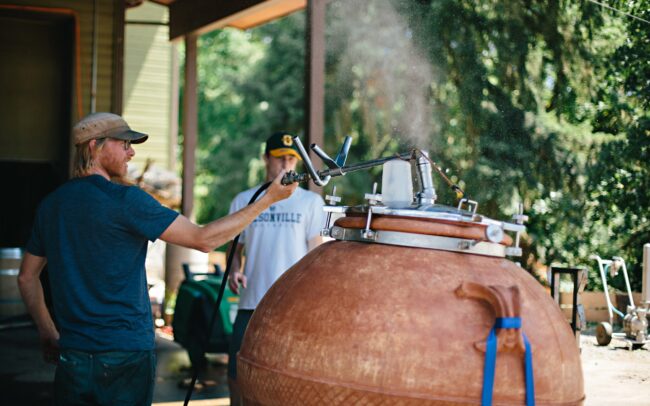
Winemaking
HANDLING Our technique is characterized by minimal handling. Fermentation is allowed to occur spontaneously, relying on “wild” indigenous yeast, and tended to the old-fashioned way with punch downs and pump overs by hand throughout the day (and night).
PRESSING We empty the tank into our press and the new wine is then moved into French oak barrels. The proportion of new barrels vs. neutral ones varies according to the strength and concentration of the vintage, usually about 30 to 50%.
TRANSFORMATION Secondary fermentation occurs naturally at a rather relaxed pace by comparison with the ‘norm’ in our very cool barrel cellar. We feel that a long, slow process gives greater complexity of flavor, transforming raw young wine into a thing of liquid beauty.
BARREL AGING AND REDUCTIVE WINEMAKING Pinot Noir is fragile and needs to be protected from excessive exposure to oxygen. Hence, the winemaking style, once in barrel, is called “reductive,” meaning exposure to oxygen is intentionally reduced. We do not practice the typical racking process of transferring a wine from barrel to barrel to aerate. Our only racking occurs after 10- to 12-months, when we rack into a settling tank before bottling. This is the only time the wine is exposed to air, and even then, it is minimal in order to protect the aromatics. Aging on lees in our cold cellar, and the fact that there is no movement of the wine (racking) until bottling, results in a buildup of CO2 – a by-product of the secondary/malolactic fermentation. This serves as a natural preservative and allows us to use far less sulphur than most wine producers. All of this is aimed at preserving the character of our terroir, the personality of the vintage, and the quality of the wine.
Aging & When To Open
Please have some patience as the potential of our wine unfolds in the years ahead. On the other hand, we’ve been known to pull corks long before it’s warranted, and the joyful, fresh stage can be lovely. In short, enjoy the unique intersection of vintage and vineyard when the time is right for you. Wines from cooler seasons require more initial patience while they blossom in the bottle (7 to 10 years or more). Wines from warmer, quicker ripening seasons are often lush at release and quick to evolve in bottle.
A NOTE ON EFFERVESCENCE
By capturing CO2 that accumulates during secondary fermentation (instead of letting it escape before the bottling process), we are able to rely largely on this naturally occurring preservative as opposed to using lots of sulfur. This is a very traditional Old World strategy that helps our wines to evolve more slowly in the bottle. All of this is aimed at preserving the character of our terroir, the personality of the vintage, and the quality of the wine. If you find it noticeable, you may opt to decant the wines to allow any perceived effervescence to escape, swirl your glass gently for a moment, or simply wait for it to recede 20 – 30 minutes after popping the cork.




